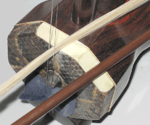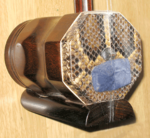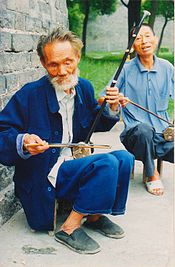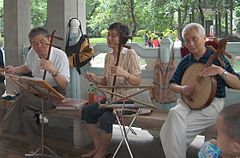- Erhu
-
Erhu 
Classification - Bowed string instrument
Related instruments The erhu (二胡; pinyin: èrhú, [êɻxǔ]) is a two-stringed bowed musical instrument, more specifically a spike fiddle, which may also be called a "southern fiddle", and sometimes known in the Western world as the "Chinese violin" or a "Chinese two-stringed fiddle". It is used as a solo instrument as well as in small ensembles and large orchestras. It is the most popular of the huqin family of traditional bowed string instruments used by various ethnic groups of China. A very versatile instrument, the erhu is used in both traditional and contemporary music arrangements, such as in pop, rock, jazz, etc.[1]
Contents
History
The erhu can be traced back to instruments introduced into China more than a thousand years ago. It is believed to have evolved from the xiqin (奚琴), which was described as a foreign, two-stringed lute in Yue Shu (樂書, yuèshū, lit. book of music), an encyclopedic work on music written by music theorist Chen Yang in the Northern Song Dynasty. The xiqin is believed to have originated from the Xi people of Central Asia, and have come to China in the 10th century.
The first Chinese character of the name of the instrument (二, èr, two) is believed to come from the fact that it has two strings. An alternate explanation states that it comes from the fact that it is the second highest huqin in pitch to the gaohu in the modern Chinese orchestra. The second character (胡, hú) indicates that it is a member of the huqin family. The name huqin literally means "barbarian instrument," showing that the instrument likely originated from regions to the north or west of China inhabited by non-Han peoples.
Historical erhu and bowed string bows
Historic bowed zithers of China, including the xiqin, yazheng, and yaqin, and also the Korean ajaeng, were originally played by bowing with a rosined stick, which created friction against the strings. As soon as the horsehair bow was invented, it spread very widely. This is a high pitched instrument. The Central Asian horse peoples occupied a territory that included the Silk Road, along which goods and innovations were transported rapidly for thousands of miles across Eurasia.
Construction
The erhu consists of a long vertical stick-like neck, at the top of which are two large tuning pegs, and at the bottom is a small resonator body (sound box) which is covered with python skin on the front (playing) end. Two strings are attached from the pegs to the base, and a small loop of string (qian jin) placed around the neck and strings acting as a nut pulls the strings towards the skin, holding a small wooden bridge in place.
The erhu has some unusual features. First is that its characteristic sound is produced through the vibration of the python skin by bowing. Second, there is no fingerboard; the player stops the strings by pressing their fingertips onto the strings without the strings touching the neck. Third, the horse hair bow is never separated from the strings (which were formerly of twisted silk but which today are usually made of metal); it passes between them as opposed to over them (the latter being the case with western bowed stringed instruments). Lastly, although there are two strings, they are very close to each other and the player's left hand in effect plays as if on one string.
The inside string (nearest to player) is generally tuned to D4 and the outside string to A4, a fifth higher. The maximum range of the instrument is three and a half octaves, from D4 up to A7, before a stopping finger reaches the part of the string in contact with the bow hair. The usual playing range is about two and a half octaves.
Various dense and heavy hardwoods are used in making the erhu. According to Chinese references the woods include zi tan (紫檀 red sandalwood and other woods of the genus Pterocarpus such as padauk), lao hong mu (老红木 aged red wood), wu mu (乌木 black wood), and hong mu (红木 red wood). Particularly fine erhus are often made from pieces of old furniture. A typical erhu measures 81 cm from top to bottom, the length of the bow also being 81 cm.
The parts of the erhu:
- Qín tong (琴筒), sound box or resonator body; it is hexagonal (liu jiao, southern), octagonal (ba jiao, northern), or, less commonly, round.
- Qín pí/She pí (琴皮/蛇皮), skin, made from python. The python skin gives the erhu its characteristic sound.
- Qín gan (琴杆), neck.
- Qín tou (琴头), top or tip of neck, usually a simple curve with a piece of bone or plastic on top, but is sometimes elaborately carved with a dragon's head.
- Qín zhou (琴轴). tuning pegs, traditional wooden, or metal machine gear pegs.
- Qiān jin (千斤), nut, made from string, or, less commonly, a metal hook.
- Nèi xián (内弦), inside or inner string, usually tuned to D4, nearest to player.
- Wai xián (外弦), outside or outer string, usually tuned to A4.
- Qín ma (琴码), bridge, made from wood.
- Gong (弓), bow, has screw device to vary bow hair tension.
- Gong gan (弓杆), bow stick, made from bamboo.
- Gong máo (弓毛), bow hair, usually white horsehair.
- Qín diàn (琴垫), pad, a piece of sponge, felt, or cloth placed between the strings and skin below the bridge to improve its sound.
- Qín tuō (琴托) - base, a piece of wood attached to the bottom of the qín tong to provide a smooth surface on which to rest on the leg.
Most erhu are mass produced in factories. The three most esteemed centres of erhu making are Beijing, Shanghai, and Suzhou. In the collectivist period after the establishment of the People's Republic of China, these factories were formed by merging what had been previously private workshops. Although most erhu were machine-made in production lines, the highest quality instruments were hand made by specialist craftsmen.[2]
In the 20th century, there have been attempts to standardize and improve the erhu, with the aim of producing a louder and better sounding instrument. One major change was the use of steel strings instead of silk. The move to steel strings was made gradually. By 1950, the thinner A string had been replaced by a violin E string with the thicker D string remaining silk. By 1958, professional players were using purpose made D and A steel erhu strings as standard.[3]
Use of python skin
In 1988, China passed its Law on the Protection of Endangered Species after ratifying the UN Convention on the International Trade in Endangered Species (CITES), making it illegal to use and trade unlicensed pythons.[4] To regulate the use of python skins, China's State Forestry Administration introduced a certification scheme between python skin sellers in Southeast Asia and musical instrument makers in China. From January 1, 2005, new regulations also require erhus to have a certificate from the State Forestry Administration, which certify that the erhu python skin is not made with wild pythons, but from farm-raised pythons. Individuals are allowed to take up to two erhus out of China when traveling; commercial buyers need additional export certificates.
Outside China, manufacturers of erhu are able to issue their own CITES licenses with approval by governments of their respective countries. Such exports are legal as they have been made from legal skin sources.
Some erhus are made of recycled products.
Erhu music
A notable composer for the erhu was Liu Tianhua (刘天华/劉天華; Liú Tiānhuá) (1895-1932), a Chinese musician who studied Western music as well. He composed 47 exercises and 10 solo pieces (1918-32) which were central to the development of the erhu as a solo instrument. His works for the instrument include Yue Ye (月夜; Yuè yè, Moon Night) and Zhu ying Yao hong (烛影摇红; Zhú yǐng yáo hóng, Shadows of Candles Flickering Red).
Other solo pieces include Er Quan Ying Yue (1950, Moon Reflected on Second Spring) by A Bing, Sai Ma (Horse Race) by Huang Haihuai, Henan Xiaoqu (Henan folk tune) by Liu Mingyuan, and Sanmenxia Changxiangqu (1961, Sanmen Gorge Capriccio) by Liu Wenjin. Most solo works are commonly performed with yangqin accompaniment, although pieces such as the ten solos by Liu Tianhua and Er Quan Ying Yue originally did not have accompaniment.
In addition to the solo repertoire, the erhu is also one of the main instruments in regional music ensembles such as Jiangnan sizhu, Chinese opera ensembles, and the modern large Chinese orchestra.
The erhu is also used in the music of the Cirque du Soleil show O. Even fusion progressive rock groups like The Hsu-nami have incorporated the erhu into their music and it is their lead instrument. It is also incorporated in the Taiwanese black metal band ChthoniC. The Erhu is also used in the song Field Below by Regina Spektor.
An Erhu instrumental album Along the River During the Qingming Festival (清明上河图;Qingming Shanghe tu) was issued at Nov 22nd 2006,Performed by a famous youth erhu artist Song Fei (宋飞; Song Fei),to express a picture draw in the Song Dynasty by Zhang Zeduan (张择端; Zhang Zeduan),the play was performed by Erhu,Jinghu,Banhu,Gaohu etc. to show the Livelihood,Trade,Festival of the Song Dynasty,the album contains 18 parts.The album represented the greatest achievement of Chinese classical music and it made the China's modern national landmark music works.
The erhu (played by George Gao) is also featured prominently in the soundtrack for the TV series Earth: Final Conflict.
In 2009's Star Trek soundtrack by Michael Giacchino, an erhu solo is featured in the soundtrack "That New Car Smell."
Playing technique
- Tuning
The erhu is almost always tuned to the interval of a fifth. The inside string (nearest to player) is generally tuned to D4 and the outside string to A4. This is the same as the two middle strings of the violin.
- Position
The erhu is played sitting down, with the sound box placed on the top of the left thigh and the neck held vertically.
- Right hand
The bow is held with an underhand grip. The bow hair is adjusted so it is slightly loose. Tension is provided by the fingers of the right hand. The bow hair is placed in between the two strings and both sides of the bow hair are used to produce sound, the player pushes the bow away from the body when bowing the A string (the outside string), and pulls it inwards when bowing the "inside" D string.
Aside from the usual bowing technique used for most pieces, the erhu can also be plucked, usually using the second finger of the right hand. This produces a dry, muted tone (if either of the open strings is plucked, the sound is somewhat more resonant) which is sometimes desired in contemporary pieces.
- Left hand
The left hand alters the tone of the strings by pressing on the string at the normal harmonic points. As the instrument has no frets, the tone is slightly muddled, but resonant. Techniques include hua yin (slides), rou xian (vibrato), huan ba (changing positions), etc.
Notable performers
Prior to the 20th century, most huqin instruments were used primarily to accompany various forms of Chinese opera and narrative. The use of the erhu as a solo instrument began in the early 20th century along with the development of guoyue (literally "national music"), a modernized form of Chinese traditional music written or adapted for the professional concert stage. Active in the early 20th century were Zhou Shaomei (周少梅, 1885-1938) and Liu Tianhua (刘天华, 1895-1932). Liu laid the foundations of modern erhu playing with his ten unaccompanied solos and 47 studies composed in the 1920s and 1930s. Liu Beimao (刘北茂, 1903-1981) was born in Jiangyin, Jiangsu. His compositions include Xiao hua gu (1943) (Little flower drum). Jiang Fengzhi (蔣风之) (1908-1986) and Chen Zhenduo (陈振铎) were students of Liu Tianhua, the piece Hangong Qiuyue (Autumn Moon Han Palace) was adapted and arranged by Jiang. Hua Yanjun (A Bing) (华彥君-阿炳, c. 1893-1950) was a blind street musician. Shortly before his death in 1950, two Chinese musicologists recorded him playing a few erhu and pipa solo pieces, the best known being Erquan Yingyue.
With the founding of the PRC and the expansion of the conservatory system, the solo erhu tradition continued to develop. Important performers during this time include Lu Xiutang (陆修堂, 1911-1966), Zhang Rui (张锐, 1920- ) Sun Wenming (孙文明, 1928-1962), Huang Haihuai (黄海怀), Liu Mingyuan (刘明源, 1931-1996), Tang Liangde (汤良德, 1938-2010), Zhang Shao (张韶), and Song Guosheng(宋国生).
Liu Mingyuan (刘明源) (1931-1996) was born in Tianjin. He was known for his virtuosity on many instruments of the huqin family, in particular the banhu. His compositions and arrangements include Henan Xiaoqu (Henan folk tune), and Cao Yuan Shang (On Grassland) for zhonghu. For many years he taught at the China Conservatory of Music in Beijing.
Tang Liangde (Tong Leung Tak, 汤良德, 1938-2010) was born in Shanghai into a famous Shanghainese musical family. He won the "Shanghai's Spring" erhu competition and continued to be the soloist for the Chinese Film Orchestra in Beijing, his composition and solos can be heard throughout the Nixon to China documentary movie. Tang was the soloist and performed at the Hong Kong Chinese Orchestra, then went onto music broadcasting and education for the Hong Kong Government's Music Office making worldwide tours, and was named Art Educator of the Year in 1991 by the Hong Kong Artist Guild.
Wang Guotong (王国潼, b. 1939) was born in Dalian, Liaoning. He studied with Jiang Fengzhi, Lan Yusong and Chen Zhenduo, and in 1960 graduated from the Central Conservatory of Music in Beijing. He performed the premiere of Sanmenxia Changxiangqu (Sanmen Gorge Rhapsody) composed by Liu Wenjin. In 1972 Wang became the erhu soloist, and later art director, with the China Broadcasting Traditional Orchestra. He returned to the Central Conservatory of Music in 1983 as head of the Chinese music department. He has written many books and articles on erhu playing and has performed in many countries. Wang also worked with the Beijing National Instruments Factory to further develop erhu design.
Min Huifen (閔惠芬, 1945- ) was born in Yixing, Jiangsu. Min first became known as the winner of the 1964 fourth Shanghai Spring national erhu competition. She studied with Lu Xiutang and Wang Yi, and graduated from the Shanghai Conservatory of Music in 1968, and became the erhu soloist with the Shanghai minzu yuetuan (Shanghai Folk Orchestra).
Yang Ying (杨英, b. 1959) was the featured soloist for the Chinese National Song and Dance Ensemble (中央歌舞团) of Beijing from 1978-1996. She was a national erhu champion, frequently recorded for the Chinese film and record industry, and is listed in famous persons of China.
The erhu is featured along with other traditional Chinese instruments such as the pipa in the contemporary Chinese instrumental music group, Twelve Girls Band. They perform traditional Chinese music as well as Western classical and popular music.
A few groups have utilized the erhu in a rock context. The Taiwanese black metal band Chthonic uses the erhu; they are the only black metal band to do so. The New Jersey-based progressive rock band The Hsu-nami plays a variety of rock sub-styles including metal, psychedelic, prog rock, and funk. An amplified erhu takes the place of lead vocals. Chie Mukai of the Japanese improv unit Ché-SHIZU also plays the erhu.
Another group which falls more under Electronica/Drum & Bass is a musical duo from Parkdale, Toronto, Ontario, Canada. The group, known as USS or Ubiquitous Synergy Seeker, uses an erhu in a different context. The USS sound is a mixture of drum and bass beats, grunge-like guitar riffs and 2-step rhythms. The erhu is one of their notable instruments they use in the course of their two released CDs, "Wielding the C:/" and "Questamation".
Toronto physician and composer Dr. Ian Pun (潘彥衡 b.1965) uses erhu combined with funk guitar musical riff in the 2011 song "加油, 加油, 加油!" performed by noted York University musicians Amely Zhou and Jaro Dabrowski.
See also
- Dan nhi
- Haegeum (traditional Korean musical instrument)
- Huqin
- Music of China
- String instruments
- Traditional Chinese musical instruments
References
- Jones, Stephen (1995). Folk Music of China. Oxford: Clarendon Press OUP.
- Liu, Terence M. (1988). "Development of the Chinese Two-stringed Bowed Lute Erhu Following the New Culture Movement (c. 1915-1985)." Ph. D. dissertation. Kent, Ohio: Kent State University.
- Stock, Jonathan. "A Historical Account of the Chinese Two-Stringed Fiddle Erhu." Galpin Society Journal, v. 46 (March 1993), pp. 83-113.
- Stock, Jonathan P. J. (1996). Musical Creativity in Twentieth-Century China: Abing, His Music, and Its Changing Meanings. Eastman Studies in Music. Rochester, New York: Rochester University Press.
- Wang, Yongde (1995). Qing shao nian xue er hu (Young person's erhu study). Shanghai Music Publishing House.
Notes
- ^ http://www.philmultic.com/home/instruments/erhu.html
- ^ Stock, Jonathan. "A Historical Account of the Chinese Two-Stringed Fiddle Erhu." Galpin Society Journal, v. 46 (March 1993), p 85
- ^ Stock, Jonathan. "A Historical Account of the Chinese Two-Stringed Fiddle Erhu." Galpin Society Journal, v. 46 (March 1993), p 103
- ^ AFP, Beijing (13 September 2005). "Erhus sing as snakes gently weep". Taipeitimes.com. http://www.taipeitimes.com/News/feat/archives/2005/09/13/2003271531. Retrieved 14 September 2010. [a Taipei Times article
Audio sample
External links
- www.ErhuBook.com Playing Erhu - Bridging the Gap, an instructional book in English by Patty Chan
- www.wen321.com, Erhu Q ( Erhu Q )
- www.59mai.com, Erhu Prices (JieLun Erhu Prices)
- Chineseerhumusic.info, Erhu Music (Listen to some Erhu Music)
- Erhu photo gallery (also includes another link to an audio clip)
- Gusli.su, Erhu music listen (also about Jia Peng Fang music)
- Datungarts.net Professional erhu, banhu, zhonghu and matouqin etc.
- Softist.com, ErhuGuanyin (A free Windows application for erhu tuning and interval training).
Video
- Horses: Lang Lang and Lang Guo-ren
- Progressive erhu funk Add oil 加油, 加油, 加油! by Ian Pun
- Signature erhu piece "Sanmen Gorge Capriccio" by Yang Ying
- Yang Ying performing "Horse Race" on Chicago PBS television
- Erhu video by Wang Guowei
- Erhu videos by Wang Guowei
- Karen Han performing "Csardas" by Monti
- Jiebing Chen beginning erhu instruction video
- Performance of "Erquan Yingyue" (with yangqin accompaniment)
- Erhu Videos by George Gao
- Rongchun Zhao video "10,000 Galloping Horses" (link at bottom of page)
- CNERHU.cn
Traditional Chinese musical instruments Silk (string) Plucked Guqin · Se · Guzheng · Konghou · Pipa · Sanxian · Ruan · Liuqin · Yueqin · Qinqin · Duxianqin Bowed Huqin · Erhu · Zhonghu · Gaohu · Banhu · Jinghu · Erxian · Tiqin · Tihu · Yehu · Tuhu · Jiaohu · Sihu · Sanhu · Zhuihu · Zhuiqin · Leiqin · Dihu · (Xiaodihu · Zhongdihu · Dadihu) · Gehu · Diyingehu · Laruan · Matouqin · Yazheng Struck Yangqin · Zhu Bamboo (woodwind) Flutes Dizi · Xiao · Paixiao · Koudi Oboes Guan · Suona Free-reed pipes Bawu · Mangtong Gourd (woodwind) Sheng · Yu · Hulusi · Hulusheng Percussion Wood Muyu · Paiban · Guban Stone Bianqing Metal Bianzhong · Fangxiang · Luo · Yunluo Clay Fou Hide Daigu · Bangu · Paigu · Tanggu Others Xun · Gudi · Lusheng · Kouxian Huqin instrument family Erhu • Gaohu • Banhu • Jinghu • Zhonghu • Yehu • Erxian • Tiqin • Daguangxian • Datong • Datongxian • Hexian • Huluhu • Maguhu • Tuhu • Jiaohu • Zhuihu • Zhuiqin • Leiqin • Sihu • Sanhu • Dahu • Dihu • (Xiaodihu • Zhongdihu • Dadihu) • Cizhonghu • Gehu • Diyingehu • Laruan (Dalaruan) • Paqin • Xiqin • Niutuiqin (niubatui) • Matouqin • Aijieke • SataerCategories:- Chinese musical instruments
- Necked bowl lutes
- Bowed instruments
- Drumhead lutes
- Continuous pitch instruments
- Erhu players
Wikimedia Foundation. 2010.







